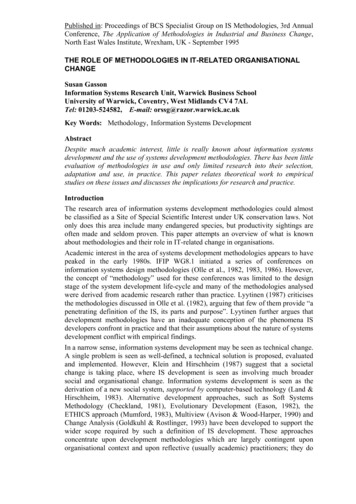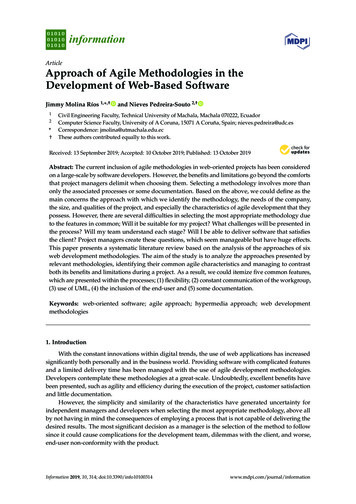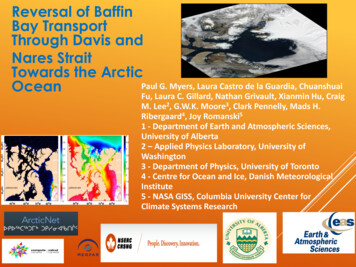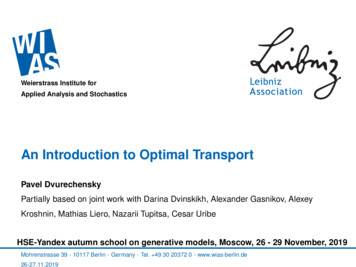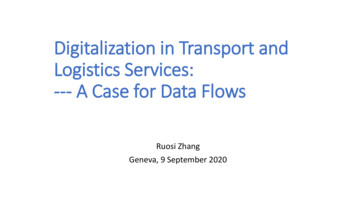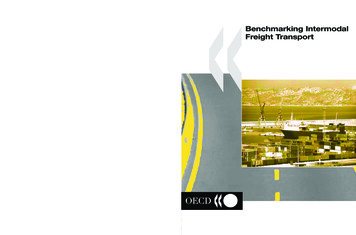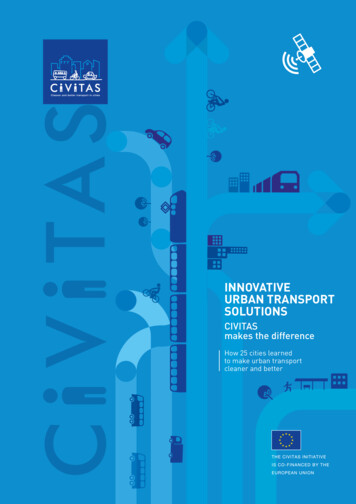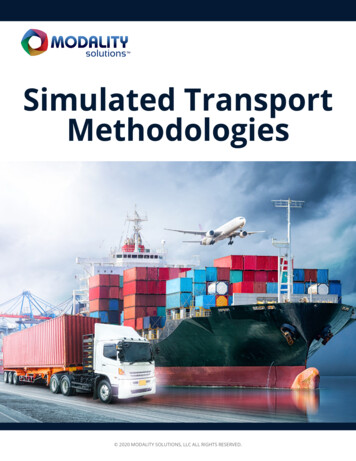
Transcription
SIMULATED TRANSPORT METHODOLOGIES MODALITY SOLUTIONSSimulated TransportMethodologies 2020 MODALITY SOLUTIONS, LLC ALL RIGHTS RESERVED.1
SIMULATED TRANSPORT METHODOLOGIES MODALITY SOLUTIONSIntroductionSimulated transport can be a valuable technique in determining the physical stability of drugproduct protein solutions, including vaccines, monoclonal antibodies, antibody-drug conjugates(ADCs), and gene therapies. Large molecule drug products may be susceptible to denaturing whenexposed to common transport hazards present in all supply chains [1]. These hazards are shock,vibration, temperature, pressure, and humidity. The simulation is intended to expose the productto the concurrent combination of these hazards at worst-case locations in the operating space.Unlike ASTM-based testing[2], the hazards are applied concurrently and at levels that reflect thehazards in the supply chain.BackgroundThe history of this methodology goes back to circa 2000 with the discovery of particulatesduring the inspection of drug product validation batches being transported from the point ofmanufacture to a stability site. It was determined that the selected formulation was susceptibleto transportation hazards. The finding, in late drug product development stages, resulted in adelayed launch of the product while a more stable formulation was selected.Word of this occurrence was made public at multiple conference venues, [3,4]. Upon hearingabout this, companies began simulations of their molecules to gain an early determination of thephysical stability of the many product formulations in development.Scientists at the University of Colorado-Boulder have been studying the physical stability ofmonoclonal antibodies for over 20 years, [5]. Their findings attest to the denaturing of therapeuticprotein solutions when exposed to shock and vibration. Additional studies have shown multiplevariables that are determinate factors in physical stability. Those factors include container type,fill volume, protein concentration, pH, and selected buffer additives, [6]. 2020 MODALITY SOLUTIONS, LLC ALL RIGHTS RESERVED.2
SIMULATED TRANSPORT METHODOLOGIES MODALITY SOLUTIONSApplicability and TimingA good understanding of the shipping lanes is necessary to ensure that the simulated transportreflects the actual supply chain. Modality Solutions strongly encourages the use of analyticalresults from samples exposed to transport simulation are included in the BLA filing. This datademonstrates product robustness to worst-case distribution hazards.An initial transport simulation is advised well before filing. This first test may be on engineeringbatches or before a final formulation decision is made. This testing allows for an appraisal of twoor more candidate formulations and builds product knowledge at the earliest possible time indevelopment.The use of data from samples exposed to simulated shock, vibration, humidity, temperature, andpressure is a best practice that supplements and possibly reduces the number of studies neededfrom actual shipments. In general, a sufficient number of samples from the validation batchesare used for this test and analyzed along with the registration stability samples, allowing for acomparison to be made between transported and quiescent samples in the BLA filing.Transport HazardsThere are many sources and standards for consideration as to the levels and types oftransport hazards. When the vibration profiles referenced as “Industry Standards” were created,the users at the time were suppliers of durable goods in LTL freight, airfreight, and ocean liner. Aconsensus between test equipment suppliers, test labs, and the users were reached to balancetests and equipment costs. The resulting ASTM standards were vibration profiles that wereaccelerated to reduce the time and cost of the testing.Therapeutic protein solutions do not respond to the sequential accelerated hazard testing, andusing the cited methods in ASTM 4169 will not replicate results from actual shipments. Thisrealization is the current understanding of several regulatory agencies.Testing for these classes of biologic drug products must reflect the actual hazard levels as theyoccur in the field. A real-time transport simulation study allows for the concurrent exposure of thedrug product to temperature, pressure, shock, humidity, and vibration as they occur in the supplychain.Some level of diligence must be exercised to define the supply chain and establish the levelsof each hazard used during simulated transport. The following sections discuss each hazardseparately, but the goal is to apply them concurrently. 2020 MODALITY SOLUTIONS, LLC ALL RIGHTS RESERVED.3
SIMULATED TRANSPORT METHODOLOGIES MODALITY SOLUTIONSTemperatureThe sponsor determines the temperature levels set during simulated transport. With arefrigerated product, it is appropriate to acknowledge that the process capability of thesupply chain occasionally results in temperature exposures that are outside of the 2 - 8 C storagespecification, yet are not severe enough to reflect the ICH upper and lower bounds of 25 C or-20 C. These exposure instances may occur during loading/unloading of the drug product aswell as occasional HVAC failures during storage or transport. Further, the ICH methodologyexposes one set of samples to high temperature and the second set of samples to low temperature.Modality Solutions’ methodology recognizes the reality that a single shipment could be exposedto both hot and cold exposures.It is recommended, and the decision of many clients to demonstrate that short (2-5 hours)exposures outside of the labeled storage range do not affect the product’s Critical QualityAttributes (CQAs). Splitting the total simulation time at those high and low-temperature valuesassure that “mild” temporary exposures are tolerable. Modality Solutions has tested refrigeratedproducts as low as -4 C and as high as 15 C. Modality Solutions laboratory testing capability fortemperature runs between -35 to 60 VibrationAs mentioned in the introduction and background, it is critical to select non-accelerated energylevels and intensities that reflect the supply chain. The goal here is not to accelerate the testing,but to replicate all the hazards as they would normally occur. While it may seem counter-intuitive,accelerated vibration levels may result in under testing of the product, [7]. Therefore, vibrationtesting should be conducted in real-time and use profiles that reflect vibration levels seen in ocean,ground, and air shipments.HumidityHumidity levels can have an impact on a drug product’s quality, in particular on MABsproducts absorb excess moisture in the air if not properly protected. This increase in moistureabsorption can compromise potency and effectiveness due to hydrolysis mechanisms [8]. Thus, it isimportant to include humidity as a transport hazard in simulations with drugs that may havesuspectable damage caused by excess moisture. Modality Solutions uses relative humidityvalues that represent a worst-case shipment for a drug product’s supply chain. 2020 MODALITY SOLUTIONS, LLC ALL RIGHTS RESERVED.4
SIMULATED TRANSPORT METHODOLOGIES MODALITY SOLUTIONSPressureMost shipments are exposed to low pressure if any segment includes air transport or highelevation truck shipments. The FAA, [9] designates that pressurized aircraft be pressurized to avalue at or below an equivalent of 8,000 ft. In most cases, for crew and passenger comfort duringthe flight, the working value is closer to 6,000 ft. Truck shipments routed through Loveland passin Colorado are exposed to pressures values at 11,9900 ft, lower than values observed in airshipments. Unlike ASTM 6653 that directs that low-pressure exposures are one hour, ModalitySolutions recommends extended, multiple exposures that reflect the supply chain.ShockA critical element in any simulation of transport hazards is shock events. Shock events refer towhen package or pallet is physically impacted and is somewhat random, with the intensity beingdependent upon the method of shipment. Products loaded on heavy pallets characteristicallyare exposed to infrequent and low levels of shock within a supply chain. Product shipped as aparcel is subjected to more shock events with greater intensity because of automated high-speedhandling and sorting at each node within the supply chain. Remarkably the timing of the shockevents has little effect on the outcome of a study. It is the number of events that is critical toachieving consistent field to lab results.Extensive work at University Colorado-Boulder confirms the denaturing effects of shock ontherapeutic protein solutions, known as cavitation [10]. As a worst-case simulation, it isrecommended that all samples be considered as being shipped in the parcel network where thelikelihood, frequency, and drop height are all the greatest.Conclusion1. If all other hazards are of equal level during shipments, a simulated supply chain thatmodels the parcel network provides the highest confidence that all other modes oftransport will be equal to or less severe.2. Simulation of the actual move times allows for sufficient and realistic exposures to act onthe drug product.3. Actual hazard data from characterized lanes are appropriate to use in simulations, butinstead of lane data, industry standards may be chosen with care taken to useun-accelerated versions of the vibration profiles. 2020 MODALITY SOLUTIONS, LLC ALL RIGHTS RESERVED.5
SIMULATED TRANSPORT METHODOLOGIES MODALITY SOLUTIONSReferences1. ANVISA: Guidance on the Qualification of Transportation of Biological Products, April 12th 20172. ASTM D4169-16 Standard Practice for Performance Testing of Shipping Containers andSystems, 20163. PDA Presentation by B. Wallin, PDA Conference, Development of a Transport SimulationTesting Program, presented 20114. CMC Forum Latin America by A. Mire-Sluis, 2015, Transport Validation, presented AUG20155. Journal Of Pharmaceutical Sciences 104:602–611, Do Not Drop: Mechanical Shock in VialsCauses Cavitation, Protein Aggregation, and Particle Formation, T. W. Randolph, et.al.Published 20156. Ibid.7. ISTA Paper, Vibration Testing Equivalence, W. I. Kipp, DEC20088. Manufacturing Chemist, RH and Its Effect on Drug Attributes, SEP20149. FAA Pressure in Aircraft, FAR Part 25 Sec. 25.841 effective as of JUL199610. Presentation by T. W. Randolph, Effects of Mechanical Shock and Cavitation in Vials on ProteinParticle Formation, circa 2013. 2020 MODALITY SOLUTIONS, LLC ALL RIGHTS RESERVED.6
SIMULATED TRANSPORT METHODOLOGIES MODALITY SOLUTIONSIF YOU ARE CONSIDERING WORKING WITH US, THIS IS WHAT YOU CAN EXPECT:1. Confidence in your cold chain. Guaranteed.2. Every engagement led by a principal.3. You can reach out anytime, anywhere, for anything.4. We solve real problems. Your cold chain will be approved.5. You will become cold chain experts.Click the buttom below to Schedule your free one-hour, no obligation consult.SCHEDULE CONSULT 2020 MODALITY SOLUTIONS, LLC ALL RIGHTS RESERVED.7
SIMULATED TRANSPORT METHODOLOGIES MODALITY SOLUTIONSThe pharmaceutical cold chain network is complex, but Modality Solutions makes it easyto simplify and streamline your cold chain.Working as a professional in the cold chain network means facing daily challenges. Just becausethe pharmaceutical cold chain network is complex doesn’t mean that your management systemmust be. Let our focused pharmaceutical cold chain engineering firm deliver results with ouradvanced technology and world-class engineers.For More Information:Visit www.modality-solutions.comCall: (888) 219-6317 or email: info@modality-solutions.comAbout Modality SolutionsWith Modality Solutions confidence in your cold chain is guaranteed--because three types ofspecialty firms combine as a single source for your cold chain management integration. ModalitySolutions is a cold chain regulatory filing authority, a logistics network operations team, and anintegrated experienced staffing firm.Services include: ensuring regulatory compliance; delivering cold chain thermal packaging design/ qualification and controlled-environment logistics solutions; conducting transport simulationtesting; providing staffing augmentation; decreasing development cycle times for fasterroute-to-market; developing transport validation strategies to support global regulatoryapplications; and support of clinical trial operations. Modality Solutions Advantage TransportSimulation Laboratory concurrently exposes product and packaging to all five environmentalhazards – temperature, shock, vibration, humidity, and pressure as they occur duringreal-world distribution. 2020 MODALITY SOLUTIONS, LLC ALL RIGHTS RESERVED.8
These hazards are shock, vibration, temperature, pressure, and humidity. The simulation is intended to expose the product to the concurrent combination of these hazards at worst-case locations in the operating space. Unlike ASTM-based testing[2], the hazards are applied concurrently and at levels that reflect the hazards in the supply chain.

